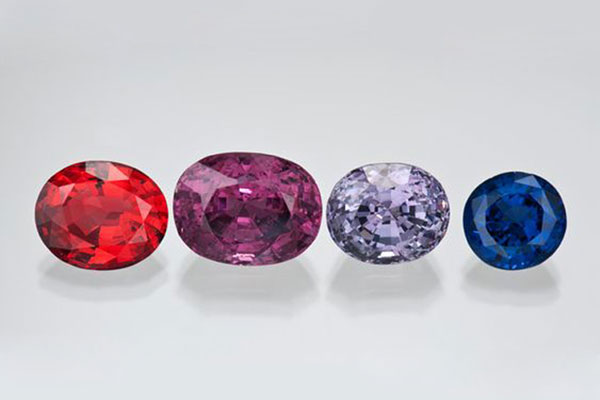The Best (& Worst) Gemstones for Engagement Rings
Choosing the right gemstone for an engagement ring can be a difficult decision as there are so many potential options but unfortunately, not all of them are a good option.
This is because an Engagement Ring is subject to quite a bit of wear a tear throughout its life and no other piece of jewelry (except a wedding ring) has to go through quite so much.
To be suitable for an engagement ring, a gemstone must be both beautiful and durable and when we are talking about gemstones, durability is defined by three separate elements:
- Hardness – this is a surface feature of the gemstone and the harder the stone, the better it can resist scratching an abrasion. For reference, we use the Mohs hardness scale for gemstones
- Toughness – this is the internal strength of the stone and its ability to resist fracture (a non-directional breakage within the stone) and cleavage (a direction breakage within the stone)
- Stability – this is the ability of the stone to resist physical changes such as heat and light and chemical changes, such as being exposed to acids and alkalis (such as beauty and cleaning products)
If a gemstone is weak in any of these areas, then it isn’t really suitable for use in an engagement ring.
The 5 Best Gemstones for Engagement Rings
For this post, I have decided to list, what are in my opinion are the five best gemstones for engagement rings.
1. Diamond
The first option on this list is a pretty unsurprising one as Diamonds are the most popular choice of gemstone for an Engagement Ring.
But there is good reason for this as not only are Diamonds very beautiful but they are also a durable gemstone.
It is a well-known fact that Diamonds are the hardest natural material in the world and it is very true that only a diamond can scratch another diamond.

But they are also reasonably tough gemstones but they are not indestructible as diamonds can suffer from both fractures and cleavage, which can cause Diamonds to break but this isn’t done easily.
They are also a very stable gemstone and unless they are exposed to extreme heat (such as a jeweler’s torch) or very strong chemicals, the color and structure of the stone won’t be affected.
This means that diamonds will not only be pretty much unaffected by day-to-day wear and tear but as long as you look after your Diamond, a quick clean should make it look just as good as the day you bought it.
Want to learn more? Then check out my Diamond Buying Guide.
2. Synthetic Moissanite
The second option is one of the most popular Diamond simulants on the market.
Synthetic Moissanite is a man-made gemstone that has many properties similar to that of Diamond and if cut well, will have more sparkle than the equivalent Diamond.
They are also a very hard gemstone, with a score of 9 1/4 on the Mohs hardness scale, which means it is not easy to scratch one of these gemstones.

Toughness is also a strong point of Synthetic Moissanite and while they can be fractured, they do not cleave. This means that it is quite difficult to break one of these gemstones and just like Diamonds, they are also very stable.
One of the big advantages to Synthetic Moissanite is that they are considerably cheaper than Natural Diamond but with the price difference with lab-created Diamonds narrowing by the day, it could be argued that a lab-created Diamond is a better option.
3. Sapphire
One of the best alternatives for Diamonds is Sapphire, especially if you want a colored gemstone in your engagement ring.
And while many people think of blue, when thinking about a Sapphire, they actually come in any color that you can think of.
This variety of colors are just one of the reasons why Sapphire is such as good option for an engagement ring.

Sapphire are a very durable gemstone and comes in at 9 on the Mohs scale along with being a very tough gemstone due to the way that Sapphire crystals form. They are also a very stable gemstone and are only at risk if exposed to extreme heat or chemical changes, which I doubt your engagement ring will be!
The price of Sapphires also makes them a very attractive alternative to Diamonds as good quality Sapphires, cost less per carat than the equivalent quality Diamond but the cost per carat does vary depending on color as Blue and Pink cost more than the same size and quality Green and Yellow.
Want to learn more? Then check out my Sapphire Guide.
4. Ruby
The next option is Sapphire’s sibling, Ruby. Both are part of the Corundum gem family and effectively, Rubies are red Sapphires.
This means that they share many of the same traits as Sapphire but Rubies are much rarer and valuable than Sapphires.
In fact, Rubies are the second most valuable gemstone in terms of price per carat after fancy color Diamonds.

In terms of durability, the only difference between Rubies and Sapphires is that Rubies are not quite as tough as their siblings and are more likely to fracture or be fractured.
If you are interested as to why this is the case, it is because Chromium, which is the element that causes the beautiful red color in Rubies is quite a large element and does affect the crystal structure.
But Rubies are still tougher than a large number of gemstones and are still a great option for an engagement ring.
Want to learn more? Then check out my Ruby Guide.
5. Spinel
The fifth option is a gemstone that you may or may not have heard of but one that is gaining in popularity every year.
Sometimes called the great pretender due to visual similarities between Spinels and Rubies and Sapphires and up until the mid-1800s, they were thought to be the same stone.
But over the past few years, they have begun to gain popularity in their own right.

While not as hard as Ruby and Sapphire, Spinels have good hardness with a score of 8 on the Mohs scale and have good toughness and stability, making them an interesting choice for an engagement ring.
But with Spinels being slightly softer than the other stones on this list, it does mean that more care needs to be taken when wearing one of these gems but they are still a great choice.
The reason why they have become so popular in the last few years is that they are a cheaper alternative to Rubies and Sapphires but the price gap has begun to narrow due to the increase in popularity, especially between Red Spinels and Rubies.
The 3 Worst Gemstones
Now there are lots of gemstones that really are not suitable for an engagement ring but these three are very popular gemstones and are often requested but I really would advise against using any of these three as they just cannot stand up to the wear and tear that an engagement ring goes through.
1. Emerald
The most popular of all of the green stones and a member of the Big Four Gemstones alongside Diamond, Ruby and Sapphire.
Unfortunately though, this very beautiful gemstone is a very unsuitable option for an engagement ring.
While the hardness of Emerald isn’t bad as it ranges from 7 – 71/4 on the Mohs hardness scale, which is around the level suitable for jewelry (7 and above is recommended for jewelry and especially rings).

The toughness of Emeralds is very poor as they are very brittle gemstones, this is because of the same element that causes the red color in Rubies, chromium. But it causes much more damage to the crystal structure of an Emerald than it does to a Ruby and that is why it is estimated that 99% of Emeralds are fractured.
Fractures can also be numerous within the stones and significantly increases the chance of the stone breaking. They are also not a particularly stable stone and this is mainly down to the fact that the majority of Emeralds are fracture filled with oils to reduce the appearance of the fractures.
But exposure to hot temperatures and also chemicals found in cleaning, beauty and cosmetic products can draw these oils out of the stone and can make them look less than desirable. While not as visually appealing, Green Sapphires are a much better choice of gemstone.
Want to learn more? Then check out my Emerald Guide.
2. Tanzanite
A gemstone with a very short history as it was only discovered in the 1950s but one that became very popular, very quickly as jewelry titans Tiffany & Co were one of the first jewelers to start using and heavily market the stone.
And while there is no doubting the beauty of Tanzanite, unfortunately, they are really not a suitable gemstone for engagement rings, even though often sold as one.

This is because they are very soft gemstones (6 on the Mohs scale) and also very brittle stones. This combination means that they do not handle the knocks and bangs that engagement rings are subjected to.
Tanzanite is much more suited to pendants and earrings that have a much easier life than rings.
3. Opals
One of my favorite gemstones and without a doubt, the most unique and beautiful gemstones in the world.
And while visually, it is very easy to see why someone would want an Opal in their engagement ring as it will be like no one other, unfortunately, it will not hold up very well.
And this applies to all Opals, from the very rare and expensive Australian Black and Crystal Opals to the more affordable Boulder Opals.

This is because Opals don’t fair very well in any of the three elements that make up durability as they are very soft (6 on the Mohs scale) and also a brittle stone due to their structure. But one of the main reasons why Opals shouldn’t be used for engagement rings is that they aren’t a very stable gemstone.
The reason for this is that Opals are made up of approximately 10% water and while this contributes the amazing play of color seen in Opals, exposure to heat and also chemicals can cause this water to be drawn out of the stone.
When this happens, the surface of the Opal will craze and this is irreparable damage to the surface of the gemstone. Opals should be cared for and only used in jewelry that protects the stone such as pendants or earrings.
Conclusion
So there it is, my list of the best and worst gemstones that you can choose for your engagement ring. Obviously, there are many more gemstones out there but I wanted to stick to the main options that are often requested for Engagement Rings and explain why they either should or shouldn’t be used.
I hope these lists have helped you either make or refine your decision on which gemstone to go for as choosing the right stone is an important part of the whole engagement ring process.
I'm Paul Haywood FGA DGA, the owner and founder of Haywoods Gems, I'm a fully qualified Gemmologist and Diamond Grader from the Gemmological Association of Great Britain.







